Lesson plan refection
Overall, I thought our lesson went really well it connected to our subject of music in social science and I thought our concept of drumming around the world was very unique. We did a good job in terms of researching background information about the specific type of African drumming we wanted to bring into the classroom and provided a short clip from a video that connected the song we were learning and tied together with our social science concept. The king is coming song we played with our students incorporated playing a tone, slap, and bass in the drumming pattern. I could have been better in terms of memorizing historical facts I wanted to bring up in order for the lesson to go smoother. I also read the information off my phone and in hindsight, it would have been more professional to have written it down on a piece of paper instead. I thought we did a good job of making sure all our students were on the same page as to what the difference between a tone slap and bass were before moving ahead with learning the song. When playing the song we taught what rhythm was and how to incorporate it within the students drumming.
In terms of incorporating the first peoples’ principles of learning, I thought we accomplished this. The principal that we focused on was Learning is embedded in memory, history, and story. Learning involves patience and time. Learning is holistic, reflexive, reflective, experiential, and relational (focused on connectedness, reciprocal relationships, and a sense of place). We definitely included the history and story aspects when we talked about the history of the djembe drum and our song. This was especially shown when we talked about the importance of using wood for the djembe drum because it connects to the family tree which connects the youth (fruit and leaves) the family (branches and the trunk) and the ancestors (the roots underground). This connectedness was also an important aspect of our lesson plan because it connects to western African historical culture. We also started our lesson with a territorial acknowledgment which I thought went very well. Further, we allowed our students to explore the drums themselves and explore the instrument in an experiential way. This I feel like could have been more structured to avoid it being chaotically loud but the experimental process was definitely valuable.
All in all, I feel like our lesson plan successfully tied music and social sciences together in a lesson that incorporated the first peoples principles of learning in a productive way.
Tutorial Videos
For students who want to start designing their own projects on different platforms, Youtube has a lot of great tutorials to help guide students to create their own projects. For instance, I was able to follow a “coding train” tutorial video to create my own coding masterpiece that demonstrates my understanding of fractals. (If I can do this anyone can)
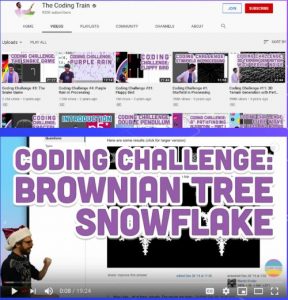

Not only did this particular YouTuber explain the math and physics as to how this would work but he also explained what every part of his code did as well as go through the process of computational thinking and debugging in the video. He sets his video up as challenges and makes the process easy to understand from the perspective of someone with limited knowledge. I did all of this in processing which is a java based processor that was free to download.
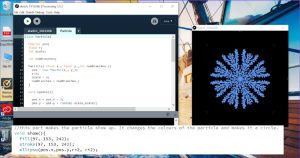
Able to show Understanding of….
- While loop: when the condition is evaluated first and if it returns true then the statements inside while loop execute. When condition returns false, the control comes out of the loop and jumps to the next statement after a while loop.
- Boolean: A Boolean value is one with two choices you can assign a value of either true or false. There is a variable type for Boolean values.
- If statement: if statements are used to test a condition (ex. If … then do this)
- Able to show that Fractals are complex patterns that are self-similar across different scales. They are created by repeating a simple process over and over in an ongoing loop.
This is an example of how coding can pull together multiple subjects like math, physics, art, science and computer science.

Code BC
I went on code BC’s website and learned about who they were and what they did.
Code BC provides a fantastic web-based workshop on the topic of Computational Thinking. Computer Using Educators of BC (CUEBC) hosts a yearly conference that brings together 500+ K-12 teachers from across BC. They encourage teachers who are not technology specialist to be a part of CUEBC who want to implement the purposeful and beneficial integration of technology into their practice. They believe in supporting teachers by providing them with extensive outreach work, consultation, professional development, and inquiry projects. Teachers’ Guide to Computational Thinking
I worked through one of their hour-long courses and I found it to be very valuable.
Free Coding Game
Flexbox Froggy
- Flexbox Froggy is a game that teaches beginner CSS coding language, similar to HTML
- features frogs who have to be moved onto their respective lily pads
- to control the frogs you type code in the format of “justify-content:_______” with the location you want them to move to in the blank (ex// flex-end, space-between, center)
- Flexbox Froggy is easy to follow, user-friendly, everyone can go at their own pace
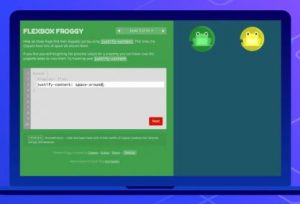
What is coding? Why should be teach it?
What is coding?
- Coding is the process of using a programming language to get a computer to behave how you want it to.
- Since computers interpret instructions through binary (1s and 0s)
- languages are used to make the process of giving instructions to a computer easier to read and the ease of creating programs.
- A few common languages include C, C++, C#, java, and python.
Why should we teach it?
- The ability to code computer programs is an important part of literacy in today’s society and is necessary for our developing technology-based world
- Learning coding puts students in control of the computer, and builds understanding in sequencing skills, counting, problem-solving, logical thinking, cause and effect, and critical thinking
- Students can express themselves through code and create games, apps, websites, etc. The earlier students are introduced to coding, the more comfortable they will be with computers and technology in the future
In BC’s New Curriculum: Applied Design, Skills, and Technology, students in grade K-5 are expected to be able to do the following:
-
- “Identify needs and opportunities for designing”
- “Use trial and error to make changes and solve problems”
- “Construct a first version of the product, making changes to tools, materials, and procedures as needed”
- “Reflect on their design thinking and processes, and their ability to work effectively both as individuals and collaboratively in a group, including their ability to share and maintain a co-operative workspace”
- “Simple algorithms that reflect computational thinking”
- “Evolution of programming language”
- “Visual programming”
Music Final
In this video, I will show the four aspects of music theory that I have learned which include inversions, octaves, diminished chords and augmented chords.
- Inversions work for any note example C can be played 3 different ways all making the same sound of C. Inversions must still include the same letter notes.
- Octaves are the next highest or lowest pitch of the same note. For example, an octave up from C1 on a piano is C2. An octave down would be C0. There are 12 semitones in the octave.
- Diminished chords sound tense, dissonant, and dramatic. They have a root note, minor third, and a diminished fifth (six semitones above the root). For example, a C diminished triad has the notes: C-E♭-G♭.
- Augmented chords sound dissonant, unsettling, and mysterious. They have a root note, major third, and an augmented fifth (eight semitones above the root). For example, a C augmented triad has the notes: C–E–G#.
The song I have chosen is “a beautiful day in the neighborhood” the Mr. Rodgers theme song. I will play the main chorus with two hands and then play the end of the song with my right hand by ear. I will also be using the pedal which will hot be shown in the video.
Coding
I really liked this class because it connected directly to my tech inquiry. It was really good to see a lot of different applications that I have been investigating outside of class. He referenced scratch which was one of my favorite applications that have been pushed for elementary grade students. Scratch is a graphical and gentle introduction to coding that gives learners immediate visual feedback from the very beginning. It is “Great for younger learners” especially if they are intimidated by coding languages. It can be used for making interesting visual projects, it is not compatible with databases or phones. Some resources feature in class to get started with Scratch included:
- Getting Started with Scratch (pdf)
- Scratch Teacher Workbook (pdf)
- Scratch Learner Workbook (pdf)
We also looked at Grasshopper, Hour of Code, and Code BC.
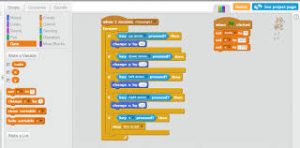
I also spent the class working on Tinker Cad. It is used for making digital 3D designs. this is what I made
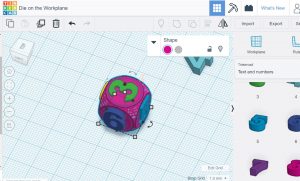
Music update 6
Overall, this has been an amazing and valuable experience. I never thought I would be able to play and enjoy an instrument like piano. After many bad experiences with music in school where I felt incapable simply because I couldn’t read sheet music. Now I know that music is much more collaborative and full of exploration. Being able to share music with my peers and learn from my peers was incredibly valuable for gaining a greater appreciation of music. I really enjoyed the atmosphere during our lectures where my peers were running lessons and when we were all playing Orff instruments, African drums, etc. At the beginning of the class, I was incredibly anxious about learning to play an instrument but now I feel so much more comfortable around music and the possibility of implementing music into my classroom.
Interviews
I had conducted interviews with three different people all at different levels in their educational careers (one a student, a new teacher, and an experienced teacher). based on what I found I complied the useful quotes I took out of this process, and this is what I found:
For my interview, I began by asking teachers in all different stages in their careers questions regarding my inquiry topic “what aspects of classroom management do new teachers struggle with the most.” I started by asking how they would define classroom management, they answered with “ability to regulate your students’ emotions/behaviour or use your students’ emotions/behaviour productively towards your goal that day,” “convey concepts in an efficient, effective manner,” “The key for sustainable management is to be authentic in your approach, flexible in your understanding of events/actions and consistent with follow-through.” Their experience ranged from learning to be a teacher having taught for only 3 years and having “10 years of working with students prior to becoming a teacher.” one teacher commented on where they thought new teachers may struggle with “developing a broader ‘toolkit’ of attention-grabbing/student catch and call strategies; communication with parents regarding management issues in their classrooms; developing/ applying non-grade specific management strategies to use as TTOCs. The ability to build rapport when you are a sub needs to take place quickly and effectively.” All of these I plan on mentioning during my argument as it brings up the idea that “management is complex, and there is no ‘magic recipe’ for success”. This is something new teachers may not understand learning to be a teacher, we think that there are set ways to run an effective class but it is far more fluid than that. Being effective at classroom management involves “Rapport with your students and school community” “Students should be comfortable approaching you, but by no means should you become their friend, it is important that you maintain a professional line”. “You must know your students before you can build trust and leadership in your actions.”One teacher, in particular, recalled a hands-on experience that they had where he was able to “ develop [his] relationship with [the student] so that she can feel more comfortable in her learning environment and asking [him] questions. Another teacher had a great method that included “learning kindness [and] explicitly teach what kindness looks, sounds, and feels like. When I ‘catch’ students being kind they earn a warm fuzzy. As a class students fill a kindness jar with warm fuzzies (tokens) and when the jar is full they receive ‘Warm-fuzzy PJ day’. For individual management, which is directly linked to whole class management I often use ‘first/then’ systems of management”.
In terms of their educational experiences in becoming teachers, for the most part, they had a positive practicum, observing and mentoring experiences. The bases of understanding pedagogy to give new teachers the best opportunities to be successful. “across the classes I either observed, participated in or instructed I was exposed to a number of different classroom management scenarios which allowed me to become a more well-rounded instructor.” By “work[ing] as an Educational Assistant, and community support worker before becoming a teacher… classroom management a seemingly natural aspect of the job” which reiterated the importance of experience.
All three teachers noted that positive encouragement and a safe environment are vital aspects of classroom management. self-regulation was also a commonly brought up topic as “positive feedback, pro-social structuring and nurturing a belief in one’s ability to self-regulate. Management is about creating learning and working atmospheres that foster positive growth, development, and social connections.” further all teachers agreed that “having clear boundaries [and expectations] is the first step to holding students accountable” as well as, when they are “explicitly stated at the beginning of the year can really have a positive impact on students. Especially if you involve the students in the creation and implementation of those expectations.” In terms of setting hard rules “class rules should help students work towards self-regulation, although I don’t think that we should expect too much from younger grades. (Use the GRR method). There shouldn’t be too many class rules that the students feel encumbered by them, but enough that they cover general behaviors.” Moreover, “teachers should maintain interactions with students that are kind and consistent. When faced with handing down consequences teachers need to be firm, fair and flexible in their approach and the consequence/actions must be justifiable and equitable in the eyes of students”.